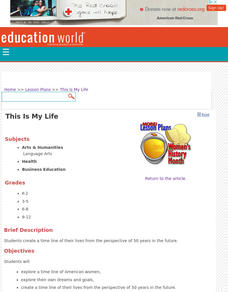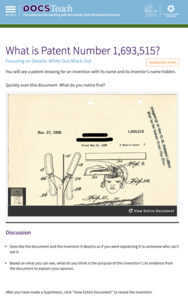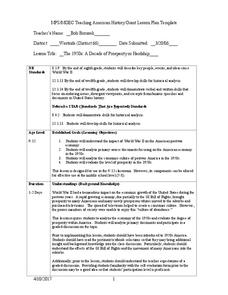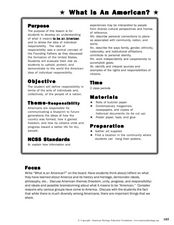Student Handouts
Geography of Dr. Martin Luther King, Jr.
Young geographers follow Dr. Martin Luther King's journey during the civil rights movement by identifying major events on a map of the eastern United States, such as his birth in Atlanta, Georgia and his famous "I Have a Dream" speech in...
Curated OER
This Is My Life
Students create a time line of their lives from the perspective of 50 years in the future.
PBS
Breaking the Code: Actions and Songs of Protest
Ezell Blair, Jr., David Richmond, Franklin McCain and Joseph McNeil changed history. Their sit-in at the lunch counter of the Woolworths in Greensboro, North Carolina on February 1, 1960 became a model for the nonviolent protests that...
Benjamin Banneker Association
Celebrate Benjamin Banneker
Inventor, astronomer, surveyor, mathematician, clock maker. Learners celebrate the life of Benjamin Banneker by building creative analog clocks, making scale models, and solving problems related to surveying. The activities model the...
National Woman's History Museum
Martha Hughes Cannon: Doctor, Wife, Mother, Senator
Each state is entitled to two statues in the National Statuary Hall Collection in Washington, D.C. After reading about Utah's debate over whether or not Martha Hughes Cannon should be represented by one of their statues, individuals...
Curated OER
Exploring the Sky: Reading Maria's Comet
Discover the science behind astronomy. After reading the book Maria's Comet, which is about a young woman who breaks new ground by becoming a female astronomer, young learners practice reading comprehension with worksheet questions about...
Curated OER
Exploring Women's History Month
Explore and celebrate the contributions of women past and present.
DocsTeach
What is Patent Number 1,693,515?
Scholars examine a document from 1928 featuring a mystery invention. Following their observations and discussion, the document reveals the invention of the permanent wave machine by Marjorie S. Joyner. Class members read about Joyner,...
The Alamo
The Alamo Then and Now
The Alamo is one of the most famous buildings from the Texas Revolution. But what does it look like today, and how has it changed? Pupils find out more using different interactive modes, including a split-screen and side-by-side version.
National Endowment for the Humanities
The Preamble to the Constitution: A Close Reading Lesson
"We the people of the United States, in order to form a more perfect union..." These familiar lines begin the Preamble to the Constitution, but do learners know what they mean? A close reading exercise takes a look at the language of the...
Curated OER
American Economics after WWII
Students analyze the American culture after WWII. Through a variety of activities, students gain an understanding of ecomonics and prosperity in the US following WWII.
Curated OER
Entrepreneurs in History
Students examine the contributions of American entrepreneurs. In this industrialization lesson, students complete the provided handouts to determine how Vanderbilt, Carnegie, Hill, and Rockefeller impacted American society. Students...
Curated OER
Bases Divided: Segregation And Discrimination in Baseball
Students view video and conduct research on how baseball has reflected the social context of American history. They work in groups to investigate outstanding minority baseball players, including racial minorities and women, and develop...
Curated OER
Documents and Symbols and American Freedom
Students complete a unit of lessons on the documents, symbols, and famous people involved in the founding of the U.S. government. They create a personal bill of rights, write a found poem, design a flag, conduct research, and role-play...
Curated OER
Language Arts, Social Studies, African Americans, The Blues, To Kill A Mockingbird
African American history during the Jim Crow era includes encounters with poverty, racism, disrespect, and protest. Harper Lee develops all four of these themes in her famous 1960 novel, To Kill a Mockingbird. To help students understand...
Curated OER
Desegregation of Schools
Students explore ways African American students were discriminated against in the 1960's. In this United States History lesson plan, students read three famous poems on the Civil Rights Movement then write their own poem.
Curated OER
Famous Figures in History
Students investigate famous people in U.S. history. In this American history instructional activity, students read about famous people such as Helen Keller and Einstein. Students think of ways they might become famous.
Curated OER
1920s Variety Show
To better understand the cultural achievements of the Harlem Renaissance and become familiar with its major figures, class members examine a painting by Aaron Douglas and a poem by Langston Hughes and compare how the artists develop...
National First Ladies' Library
Were There Two Wars for American Independence?
Students debate whether or not the War of 1812 can be counted as America's second war of independence. After researching the War of 1812, they complete a WebQuest designed to help them decide on the validity of the war as a quest for...
Curated OER
Famous Firsts Challenge
In this Black history month worksheet, learners read the statements about Black history month. Students select the best answer to complete the 10 statements.
Curated OER
Who is Robert M. Glass? - Black History Month
Students research the role of African Americans during the each of the United States' wars. In this African American history lesson, students research information and statistics about the role of African Americans in the following wars:...
Curated OER
What is an American?
Learners investigate how the definition of being American has changed over the years using online primary source documents.
Curated OER
African American Heritage in Arkansas
Students research and write about three African American composers from Arkansas: Scott Joplin, Florence Price and William Grant Still.
Curated OER
Who's Who In Black History
Fourth graders examine the life and achievements of promident African-Americans. As a class, they participate in acting out various scenes of a play which represents the Civil Rights era. They discuss how the world might be different...

























